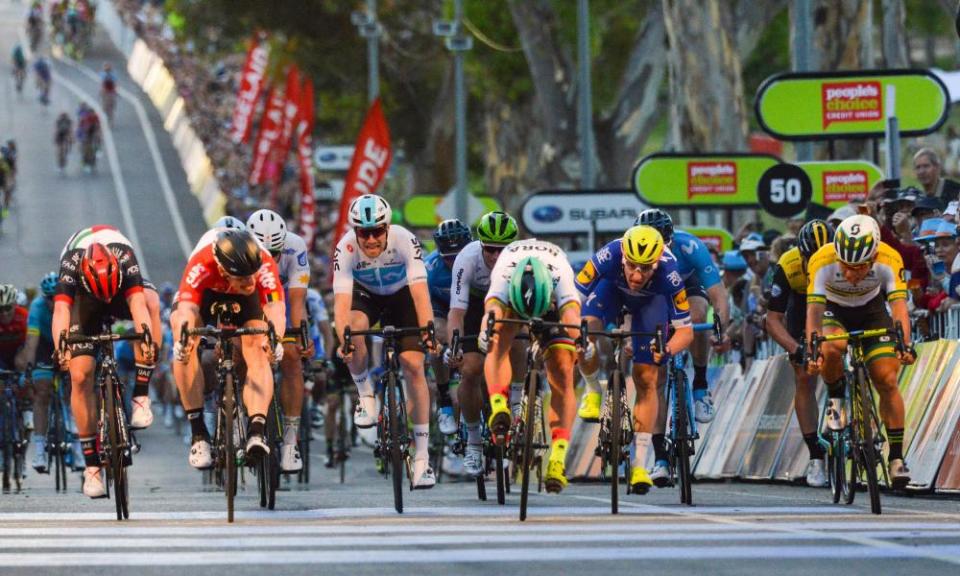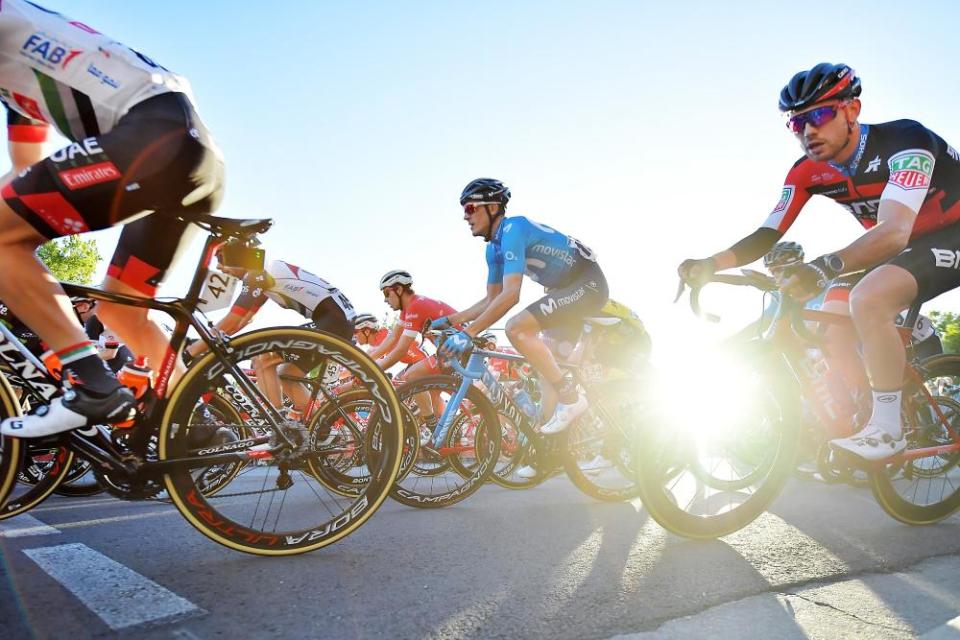Away from the big boys, cycling teams are struggling to survive

Picturesque Adelaide, the annual host to the UCI World Tour’s season opener, provides few clues as to the financial challenges facing cycling. Almost a million fans will line the roads over the coming week to watch all 18 World Tour teams contest the Tour Down Under, with the world champion, Peter Sagan, the star attraction. Sponsors are wined and dined by teams under the warm South Australian sun, existing deals consolidated and new partnerships discussed. It may lack the grandeur of its European counterparts, but the Tour Down Under – which begins on Tuesday – presents a positive image of international cycling’s top tier.
Yet not all is rosy within this multimillion-dollar sport. Cannondale-Drapac were midway through the 2017 Vuelta a España when the team announced it would fold within weeks unless £5m in sponsorship was secured. Cannondale are no minnows – Rigoberto Urán finished second at the 2017 Tour de France – but the unexpected withdrawal of a prospective partner left the team almost insolvent. While they ultimately survived, signing a new sponsor and crowdfunding over £400,000, the incident highlighted the precarious financial situation of some World Tour teams.
Elsewhere, the highly-successful Australian team Mitchelton-Scott have not secured a co-naming sponsor for 2018 following the exit of chemicals manufacturer Orica (a company linked to the owner is temporarily filling the void). The much-celebrated 2017 Road World Championships nearly bankrupted its organisers and a string of other races have been cancelled due to financial difficulties.
“Cycling is a sport that generates its income via sponsorship,” says Jim Ochowicz, the general manager of the World Tour team BMC. “None of us has a stadium we own or other means of income. Even television rights – race organisers own the rights and we do not have a revenue sharing model – so our only source of income is sponsorship. The reality of sponsors is that they do not stay forever.”
Professional road cycling has long had money troubles. In the 1990s a revolving door of teams animated the sport before dying a quick death. The commercially-oriented launch of the World Tour’s predecessor in 2005 and the slow recovery from a dark era of doping were supposed to better position the sport. But the plan to create a financially sustainable model for professional cycling remains unfinished.
While Ochowicz is upbeat, pointing to Cannondale’s survival as evidence, Mitchelton-Scott’s general manager, Shayne Bannan, admits the marketplace has become more demanding. “It is not like the old days when companies would just write a cheque and away you go,” he says.
According to Bannan the average annual World Tour team budget is £15m. Rider and staff wages constitute 80% of Mitchelton-Scott’s expenditure, with travel costs an additional £750,000 per year. 90% of the team’s income derives from partners, ranging from major sponsors to minor suppliers. The remainder comes from race fees, although these are often measly.
One consequence of straitened financial times has been an increase in the number of World Tour teams privately owned by wealthy individuals. Mitchelton-Scott is bankrolled by Gerry Ryan, who founded the team after noticing the absence of an Australian flag at the 2011 Tour de France. The businessman estimates he has put £20m into the team but says it is cash well spent. While Ryan is steadfastly committed to Mitchelton-Scott, reliance on wealthy benefactors has its own risks – as Tinkoff discovered in 2016 when their owner, the Russian billionaire Oleg Tinkov, disbanded the team.
Money is also flowing in from the Middle East and Asia. Bahrain has been accused of using its World Tour team to “launder” the country’s international reputation, tarnished by allegations of human rights abuse. In recent years Mitchelton-Scott have been at the forefront of cycling’s expansion into China; the organisation currently has a China-registered development team. Bannan is buoyant about his team’s efforts in China. “Our sport is Eurocentric,” he suggests. “We need to keep globalising the sport to create new fans.”
Another impact of the financial reality has been a widening gap between wealthy World Tour teams and the rest. Team Sky spent £31m in 2016 and French newspaper L’Equipe estimated that Katusha and BMC had comparable budgets. Some teams, though, are thought to have annual budgets below £5m. Bannan denies this disparity has made the World Tour less competitive. “Money plays a part but it is not the major part,” he says. “The most important factor is your ability to create a really good environment for your athletes.”
The spectre of doping continues to loom large. “When was the last time we had a doping ‘scandal’?” asks Bannan. “Unfortunately, that’s the perception. Last year in the World Tour a handful of riders tested positive from a peloton of almost 500. We probably have the cleanest sport in the world right now but we are not being recognised for it. Why does cycling have this inability to bring major partners on board? One of the big reasons is that lingering perception.” The Quick-Step Floors team manager, Patrick Lefevere, recently told CyclingNews that the Chris Froome controversy was an obstacle in his meetings with potential sponsors.

World Tour finances are not just a macro-level issue. Cannondale’s Brendan Canty was midway through contesting the Vuelta last year when the news broke. “It was a pretty stressful time,” says the 25-year-old. “I was racing my first Grand Tour and had just finished a hard stage. I got on the team bus, checked my phone and saw that I might not have a job for the following year.” Canty’s parents contributed to the crowd-funding campaign.
The team’s general manager for Europe, Jonathan Breekveldt, was with Canty at the Vuelta. “Cycling is a fickle business,” he says. “One of the easiest analogies is that we are a one-legged table – that leg is the sponsors. As soon as they go the whole business falls over.”
Ben Hill is another rider intimately familiar with such financial uncertainty, which is particularly rife at the tiers of racing below the World Tour. The New South Wales rider was set to join newly-formed Dynamo Cover Pro Cycling in 2016 when – just weeks before the new season – the team collapsed without having completed a single race.
“I had worked so hard to achieve that goal,” says Hill. “I went from being super happy – I was training, I was learning French – and then it sunk in. I felt defeated.” Hill had a contract with Dynamo worth around £35,000, a reasonable income at Continental level. After searching frenetically for a new team, he became a late roster addition elsewhere earning just £4,000 plus expenses for the season.
Can cycling move towards a more sustainable financial footing? At the Tour Down Under, no one is quite sure. BMC’s Ochowicz says positively: “I have been doing this a long time and I am still here.” World Tour teams are seeking structural reform – in 2014 a majority of the teams formed an organisation called Velon to help “make cycling better”. Velon has experimented with new technologies and different race formats in an effort to increase team revenue. Bannan is enthusiastic, although Breekveldt cautions that for now these remain an “investment in the future”.

 Yahoo Sport
Yahoo Sport 





































